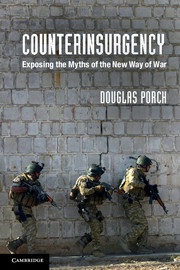Book contents
- Frontmatter
- Contents
- List of illustrations
- List of maps
- Preface and acknowledgments
- 1 A “happy combination of clemency with firmness”: the small wars prologue
- 2 The road from Sedan
- 3 The paroxysms of imperial might in the shadow of the Great War
- 4 From Tipperary to Tel Aviv: British counterinsurgency in the World War II era
- 5 From small wars to la guerre subversive: the radicalization and collapse of French counterinsurgency
- 6 Vietnam, counterinsurgency, and the American way of war
- 7 “A conspiracy of heroes”: revolution and counterinsurgency in Latin America
- 8 Building the “most successful counterinsurgency school”: COIN as the British way of war
- 9 Britain’s Thirty Years’ War in Northern Ireland
- 10 Vietnam with a happy ending: Iraq and “the surge”
- 11 Conclusion
- Notes
- Select bibliography
- Index
4 - From Tipperary to Tel Aviv: British counterinsurgency in the World War II era
Published online by Cambridge University Press: 05 June 2014
- Frontmatter
- Contents
- List of illustrations
- List of maps
- Preface and acknowledgments
- 1 A “happy combination of clemency with firmness”: the small wars prologue
- 2 The road from Sedan
- 3 The paroxysms of imperial might in the shadow of the Great War
- 4 From Tipperary to Tel Aviv: British counterinsurgency in the World War II era
- 5 From small wars to la guerre subversive: the radicalization and collapse of French counterinsurgency
- 6 Vietnam, counterinsurgency, and the American way of war
- 7 “A conspiracy of heroes”: revolution and counterinsurgency in Latin America
- 8 Building the “most successful counterinsurgency school”: COIN as the British way of war
- 9 Britain’s Thirty Years’ War in Northern Ireland
- 10 Vietnam with a happy ending: Iraq and “the surge”
- 11 Conclusion
- Notes
- Select bibliography
- Index
Summary
Thomas R. Mockaitis argues that the foundation for British success in post-World War II counterinsurgency was laid in the in the decades following the debacles at Amritsar in 1919 and Ireland between 1919 and 1921. The interwar period, rife as it was with much military innovation, he argues, saw a transition from the racist attitudes and scorched-earth tactics of nineteenth-century small wars, to the rigors of imperial policing, and with the Arab Revolt (1936–1939) in Palestine to the theory and practice of modern counterinsurgency. This change was the product of three factors: first, violence against civilians in South Africa and Ireland had appalled British and international opinion and undercut popular support for those wars. Second, there was a belated realization that in Ireland, the ferocity of Royal Irish Constabulary and Auxiliary reprisals had driven moderate Irish nationalists and IRA extremists together in a common cause against the British occupation. Finally, in the post-Great War era, tribal rebellions had been supplanted by sophisticated nationalist and communist mass political movements deploying an array of techniques that ran the gamut from strikes and protests to terrorism and insurgency.
British-style imperial policing was anchored in three fundamental principles. First, English common law dictated that disturbances must be constrained within a legal framework, which required the application of minimum force. This, in Mockaitis’ view, elevated the British counterinsurgency approach over that of the Americans who have placed great faith in the use of force. Second, confronting growing colonial unrest required the cooperation of civilian officials, the police, and soldiers to pass laws and ordinances, gather intelligence, and cooperate to apply force selectively. The reliance on a “whole of government” approach avoided the “state of siege” trap that impelled the French military to absorb most civil functions in Algeria, placed the army in the counterinsurgency vanguard, and removed civil constraints on the use of force. Finally, the British Army’s storied regimental system, versus a continental general staff hierarchy, was perfectly suited to the decentralized, flexible, small-unit organizational structure required of imperial settings.
- Type
- Chapter
- Information
- CounterinsurgencyExposing the Myths of the New Way of War, pp. 123 - 152Publisher: Cambridge University PressPrint publication year: 2013



